#general:reference
Text

FOLKTRONICA IBERICA - A Playlist
Hello everyone, @minglana and I have been working on trying to compile a playlist of all the incredible folktronica-adjacent music coming out the Iberian Peninsula in the past couple of years, and it's finally here and ready for your listening pleasure! Including everything from electro-fado and trance-like muiñeiras to arrangements of 14th century liturgical chants and revamped jotas, and spanning from the Atlantic to the Mediterranean, the playlist is roughly ordered by geographical location, starting in Portugal and moving up across the north from Galicia and Asturias through the Basque Country to Aragon and the Catalan Countries, then south to Andalusia and Extremadura. Languages include Portuguese, Galician, Asturian, Basque, Aragonese, Catalan, and Spanish. If there's any artists or song you'd like to see included, let us know and we'll add them!
#mil gràcies z per les recomanacions increïbles i també per la paciència <3#no diré quant he trigat en publicar això però ja ho podeu esbrinar crec 😅#if any of you have any further questions about the artists featured we'd be happy to answer them! or what's going on in the songs etc#there's so so much good stuff coming out now and it deserves to be celebrated and spread as far as possible#and honestly i'd love more recommendations so anyone else you guys know about would be much appreciated <3#also yow i have not posted in a while will need to think about how to fix that 😬#for now enjoy this!#general:music#catalan:music#basque:music#spanish:music#portuguese:music#galician:music#aragonese:music#general:reference#asturian:music#music#folktronica#portugal#spain#galicia#asturies#catalunya#illes balears#país valencià#euskal herria#andalucía#aragón#<- so people who are not in this corner of tumblr will maybe find this#not sure don't really know how to tag my posts so they're findable so we'll see if anything works
42 notes
·
View notes
Text
Hey hello I made a thing! As perhaps a few of you know, I have spent the last half a year being completely unhinged about Patrick O’Brian’s Aubrey-Maturin books, and I’ve always been particularly interested in the character Stephen Maturin and his relationship to Catalonia. I saw that there was a lack of stuff about this part of his identity, and, being me, I felt the need to fill it in the only way I could: compiling music and yelling about it for thirty pages. Hence this playlist.
You really don’t need to know anything about these books to listen to this playlist. You also don’t need to know anything about Catalan (I hope). Catalonia and the Catalan Countries in general (including Valencia, the Balearic Islands, and parts of southern France, Aragon, and Sardinia) have a really interesting musical and literary tradition, and I wanted to make that more accessible, so I put together a few songs I liked, translated them, and wrote a bit about each of their significance, including the most important cultural tidbits I could. Some things don’t translate super well, and I hope my Catalan followers will forgive me for trying to adapt them more for English-speaking audiences than perhaps would be preferable; I usually don’t choose to do that, but in this case I wanted to open the door, and not to intimidate people.
Now that that’s out of the way, here is a link to the PDF of the liner notes (graphic design is my passion, as they say): https://drive.google.com/file/d/1MUpRM84W8aypznEIrt0eA1jG5OxaRZvz/view?usp=sharing
Under the cut I’ve included the ephimera and unnecessary commentary that you know and love, feel free to read or ignore it as you will
These roughly follow the order of the songs and are varying levels of seriousness
If you like "Sant Joan, feu-lo ben gran" then I'd highly recommend listening to the whole Tornaveus album. I almost included the “Stabat Mater de Sudanell” and the “Goigs de Sant Julià de Lòria”, which are both from western Catalonia, and they also have more cançons de pandero, in perhaps a slightly more traditional style. A lot of the other songs have interesting cultural commentary in them, especially on feminist topics, and they’re very well-researched because literally one of the members of the group is basically the ethnomusicologist of Catalan music at the moment. Anyways, if people would like the liner notes perhaps next time I’m home I’ll scan them, they’re in Catalan and English and very well-written. Also note the legendary Lluís Llach song which has been turned into a polyphonic piece lol (and I did not include the “Goigs de la Nostra Senyora de la Llibertat” but tbh that might have been a mistake on my part) (Blorbo side note that I think this fits Stephen’s childhood very well which is mostly why I chose it)
“L’Hereu Riera” is one of my favorite Catalan folk songs I love it so much and if you want to hear the Catalan version (as opposed to the Valencian one included here) and see the dance and also see a cobla, I am including a link to this version by Germà Negre which is tragically not on Spotify. I chose the Valencian one because (1) Al Tall and (2) I think it fits The Blorbo better (specifically I was thinking of his fiancée who dies before Book One who idk if anyone ever remembers shdjfhskf). That being said, Stephen would probably know the Catalan one (and almost certainly not the Valencian one). Also, on a memey-er note, Hereu Riera bisexual king and literal icon <3 love how he has to remind his girlfriend on her deathbed that actually he'd technically be interested in both her sisters AND her brothers if he wasn't so into her that he never wanted to marry anyone else
I literally did put in Roger Mas just so there would be at least one person with a Lleidan accent, #diversity win
Many points about the “Cançó de pandero de l’Urgell” and “Jo no canto per la veu” so here we go:
I put these two songs in mostly because I got very obsessed with the cançó de pandero from Alcarràs (which is a great movie that came out last year about a farming family in a village near Lleida that is winning all the awards atm). Anyways, since Carla Simón has been too busy winning things to put up the gotdam soundtrack, I did a bit of digging and it turns out that it was written for the movie?? By her brother??? It's excellent and very anticapitalist and you can listen to it here and see the trailer for Alcarràs all in one! (Includes English subtitles)
The original “Canto per un amic meu que per mi daria la vida” is probably from a Valencian cant de batre, although I could not get any confirmation on that. But regardless everyone should listen to Pep Botifarra's version of it, which I would literally marry if it had a physical form it’s so so good. (I posted it here back in ye olden days but it's been long enough I think I can post it again)
Valencian music side note because I can’t stop myself: the second pair of verses in the "Cançó de pandero de l'Urgell" (starting with “vos esteu ben acotxada…”) are sung by Miquel Gil, who is a very famous Valencian traditional singer, anyways you should listen to this version of him singing “Del Sud” by Obrint Pas (you want to go down a Valencian music rabbit hole so so bad)
I firmly believe that Stephen would canonically be obsessed with Ausiàs March, and the fact that he has not yet recited any of his poems is Patrick O’Brian’s biggest failing in my eyes. Anyways I have more thoughts but I’m saving them for other posts shdfjsd
If you read this before listening to the playlist please just listen to "El testament d'Amèlia" and follow along with the lyrics in real time before reading the blurb, it's such a good experience to let that song hit you as it comes. I won't say more than that but you'll get it when you get it. (Also obligatory listen to Marala they're so good <3)
From the Càntut album, I also quite like the songs "El pomeró" and "El divino vull cantar", and Càntut in general is an incredible resource, it's a database of folk song field recordings from northeastern Catalonia.
Brief pause to scream about the fact that Maria Arnal and Marcel Bagés WERE ON NPR??? AND NO ONE TOLD ME???? Anyways link in the sources section, also they're great and you should listen to their whole discography
As the #1 Roba Estesa stan blog on Tumblr, listen to Roba Estesa. And Ebri Knight. And El Diluvi.
I chose this version of "La presó de Lleida" because I like it but here's a more traditional one sung by Joan Manel Serrat, another Catalan legend. Here's another one in Catalan rumba style with Sílvia Pérez Cruz singing, the sound is a bit wonky but it's also one of my favorites. The Valencian version of this song is called "La presó de Tibi" and El Diluvi have done a very explicitly anti-monarchical rendition of it (the Balearic one is "La presó de Nàpols").
I'm sorry for never putting the Sílvia Pérez Cruz version of "Corrandes d'exili" but if you want it here it is. Also note that the statue of the Virgin in the poem is a reference to the Virgin of Montserrat, it literally all goes back to her shfjkshdf (also apologies for being very bad at Christianity and Catholicism, if I mistranslated things let me know)
HOO BOY SARDANA TIME
Okay so I have a whole essay to deliver on this that I've been holding inside for the past like two months or so, I apologize in advance for my excessive pedantry on the topic.
In Master and Commander, Stephen delivers this speech:
"‘Then I must tell you that on Sunday mornings it is the custom, in that country, for people of all ages and conditions to dance, on coming out of church: so I was dancing with Ramon Mateu i Cadafalch in the square before the cathedral church of Tarragona, where I had gone to hear the Palestrina Missa Brevis. The dance is a particular dance, a round called the sardana.’"
I hate to be a hater but it is very, very unlikely that anyone would have been dancing a sardana as far south as Tarragona in this time period. The sardana as the symbol of equality and brotherhood emerged in the Renaixença and would not yet have been a thing; Stephen could well have heard sardanas in Ullastret, but they would have been a more typical folk dance, and not anything like the way they're described in the book. It's very ironic, then, that they've become THE Catalan music style for Aubreyad readers, but hopefully this playlist can change that a bit :)
(also sorry for being a sardana-hater on main, someone bring me to dance a sardana and maybe I'll feel better)
Songs that didn't make the cut: La cançó del lladre, Rossinyol que vas a França, La balanguera, La gavina - I'm always happy for more recs!
Originally, this list was also going to include songs in Irish; I quickly realized that I was in over my head with that one, but the working list of songs is here (may be subject to changes so save songs elsewhere if you like them!). Also I would add "Fé Bhláth" by Imelda May and Kíla if it was on Spotify but alas it is not; and "Amhrán na Leabhar" which I have not had time to add but was kindly recommended by someone. I'd love it if someone was interested in actually doing a proper playlist for Irish though—it's a gap in my knowledge that I'd love to start filling.
Aaaaaaand that's a wrap. I hope. Final comment to say thank you to everyone who voted in the cover image poll, turns out you all won :) (Pirineus did win and take the cover of the liner notes though)
#my masterpiece is done i have peaked i'm retiring now#jkjk but i've been working on this since like. november#so it is kind of insane that's it's finally done#please notify me of any mistakes or corrections <3#and hopefully this is enjoyable for you all!#it's a little funky at times but i think it works???#it's not really a playlist. it's more like one of those weird compilation albums that i definitely didn't consume too many of as a child#did kind of want this to show up in the aubreyad tag but i wanted links more so rip :// anyways here goes nothing#aubreyad#catalan#catalan:general#catalan:music#catalan:reference#catalan:culture#general:music#general:reference#general:culture#there'd better not be any typos or i'm fighting someone
86 notes
·
View notes
Text
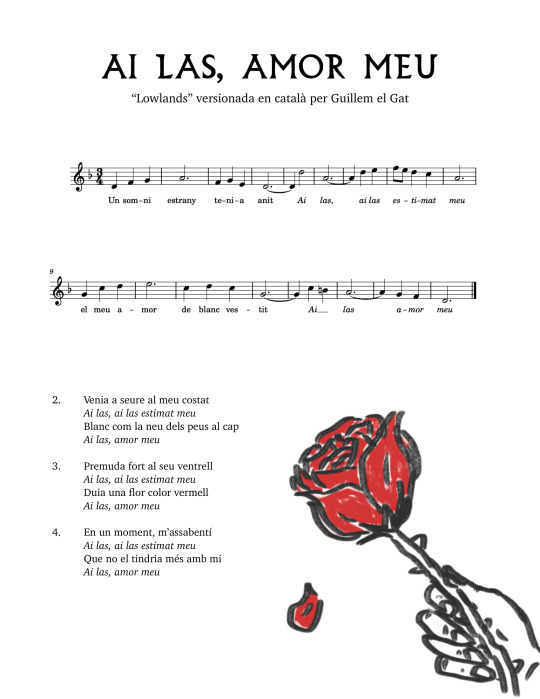
Torno amb una altra traducció d'una cançó tradicional en anglès, aquest cop "Lowlands", també coneguda com "Lowlands Away", que és un capstan shanty o una cançó que es cantava mentre els mariners feien aixecar una àncora o un altre gran pes. Els capstan shanties solen ser molt lents i suaus, ideals per la feina ponderada de fer girar l'argue o cabrestant. Aquesta té nombroses versions, però en general explica la història d'un mariner a qui se li mor la nòvia, i arriba a saber de la seva mort a través d'un "somni estrany", com diu la cançó. Jo ho he invertit, per cap raó a part de la facilitat de fer la lletra, però crec que el sentiment es manté igual. També val a dir que he triat la del cançoner que la meva família té a casa i gràcies al qual vaig arribar a conèixer la cançó en primer lloc, però que té la curiositat de que l'arranjament és en clau menor, tot i que en la gran majoria de les versions és en tonalitat major. Dit això, podeu triar el que us agradi més—la lletra val per a les dues.
I aquí, com amb l'altra, teniu una carpeta amb la imatge de dalt en forma de PDF, l'àudio, i el fitxer de Musescore, per si de cas els voleu!
(Com amb "Brindem pels companys/Here's a Health", cal dir que vinc de l'anglès i això només ha estat un exercici en ampliar i treballar el meu català, així que segurament podria ser millor 😅)
Lletra a sota / Lyrics & English translation below
Lletra original en anglès (Fireside Book of Songs)
I dreamed a dream the other night
Lowlands, lowlands away my John
My love she came all dressed in white
My lowlands away
She came to me by my bedside
Lowlands, lowlands away my John
All dressed in white like some fair bride
My lowlands away
And buried in her bosom fair
Lowlands, lowlands away my John
A red, red rose my love did wear
My lowlands away
She made no sound, no word she said
Lowlands, lowlands away my John
And then I knew my love was dead
My lowlands away
Lletra
Un somni estrany tenia anit
Ai las, ai las estimat meu
El meu amor, de blanc vestit
Ai las, amor meu
Venia a seure al meu costat
Ai las, ai las estimat meu
Blanc com la neu dels peus al cap
Ai las, amor meu
Premuda fort al seu ventrell
Ai las, ai las estimat meu
Duia una flor color vermell
Ai las, amor meu
En un moment, m’assabentí
Ai las, ai las estimat meu
Que no el tindria més amb mi
Ai las, amor meu
English Translation
I had a strange dream last night
Alas, alas my beloved
My love dressed in white
Alas, my love
He came and sat by my side
Alas, alas my beloved
White as snow from feet to head
Alas, my love
Pressed hard to his stomach
Alas, alas my beloved
He carried a flower, red in color
Alas, my love
In a moment, I realized
Alas, alas my beloved
That I wouldn’t have him with me anymore
Alas, my love
#'alas' i 'ai las' són la mateixa paraula etimològicament m'està explotant el cervell 🤯🤯🤯#anyways. espero que us agradi. i que el pony pisador miri això i decideix prendre-ho com un punt de partida per fer-ne una versió oficial <#en tinc alguns també del català a l'anglès que espero poguer penjar aquí algun dia d'aquests.......#i com a objectiu molt llunyà fer un cançoner bilingüe de cançons marineres però ara estem en examens i no tinc temps ni per pensar-ho#recomaneu-me coses si teniu alguna cançó que us faci una especial il·lusió!#i buenu. volia penjar això per octubre o novembre o algo perquè és com una mica ~spooky~ i tal però hem fet com podíem#correccions sempre benvingudíssimes <3#catalan:general#general:music#general:reference#general:translation#catalan:translation#projecte cançons del mar / sea songs#also side note but they uploaded fireside to archive.org 🥹🥹🥹 now everyone can have access to the communist folk songs 🥹🥹🥰
14 notes
·
View notes
Text
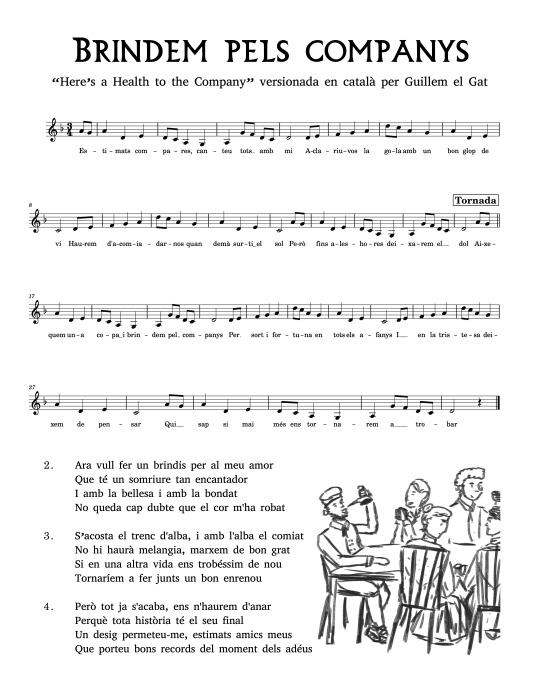
He fet una traducció de la cançó (no és ben bé un sea shanty, però podria ser) "Here's a Health" al català! Com que vinc de l'anglès, això ha estat més aviat un intent de posar el meu català a prova que no pas una versió definitiva, però crec que ha quedat bastant bé. Aquesta cançó té com deu mil versions, així que he triat la de The Longest Johns, que també s'assembla molt a la versió de The Chieftans. Dit això, he fet quatre estrofes, que ve d'una versió amb constància de Paddy Tunny, com ha comentat algú en aquest fil a Mudcat. Sigui la versió que sigui, és una cançó molt bonica i espero haver transmès una mica d'això en la meva traducció. Pels que ja la coneixeu, sisplau digueu-me com us ha semblat!
Aquí teniu una versió de la imatge en PDF, l'àudio, i el fitxer de la partitura en format de MuseScore per si us interessa. (Dit això, la imatge aquí té molt bona qualitat, la pots imprimir.)
Lletra a sota / Lyrics & English translation below
Lletra
Estimats compares, canteu tots amb mi
Aclariu-vos la gola amb un bon glop de vi
Haurem d'acomiadar-nos quan demà surti el sol
Però fins aleshores deixarem el dol
Aixequem una copa i brindem pels companys
Per sort i fortuna en tots els afanys
I en la tristesa, deixem de pensar
Qui sap si mai més ens tornarem a trobar
Ara vull fer un brindis per al meu amor
Que té un somriure tan encantador
I amb la bellesa i amb la bondat
No queda cap dubte que el cor m'ha robat
S'acosta el trenc d'alba, i amb l'alba el comiat
No hi haurà melangia, marxem de bon grat
Si en una altra vida ens trobéssim de nou
Tornaríem a fer junts un bon enrenou
Però tot ja s'acaba, ens n'haurem d'anar
Perquè tota història té el seu final
Un desig permeteu-me, estimats amics meus
Que porteu bons records del moment dels adéus
English Translation
Beloved compatriots, sing all with me
Clear your throat with a good draught of wine
We’ll have to say goodbye tomorrow when the sun comes up
But until then we will abandon our grief
We’ll raise a glass and toast to our companions
To luck and fortune in all our labors
And in sadness, we’ll stop from thinking
Who knows if we’ll ever meet again
Now I’d like to make a toast to my love
Who has such an enchanting smile
And with their beauty and with their goodness
There’s no doubt remains that they’ve stolen my heart
Dawn is getting close, and with dawn our farewell
There won’t be melancholy, we’ll leave of our own accord
If in another life we were to find each other again
We’d make a racket again together
But everything is ending, we have to go
Because every story has its end
One wish allow me, my beloved friends
That you bring good memories with you from the moment of parting
#intentant que els pony trobin aquesta lletra i en fan una versió...manifestant això per a mi....#volia fer com una partitura d'un cançoner amb dibuix i tot però el dibuix no m'acaba d'agradar#crec que ha quedat bastant bé en general per això no em deixo fer res més abans de publicar-ho#el més interessant ha sigut dividir les síl·labes és una d'aquestes diferències molt lleugeres entre els idiomes#que no ho notes fins que l'hagis de fer#i bé. si hi ha errors digueu-m'ho sisplau els corregiré tan aviat com pugui#catalan:general#catalan:music#general:music#catalan:translation#general:translation#ara amb el bloc correcte! mira quin lio :')#general:reference#catalan:reference
20 notes
·
View notes
Text


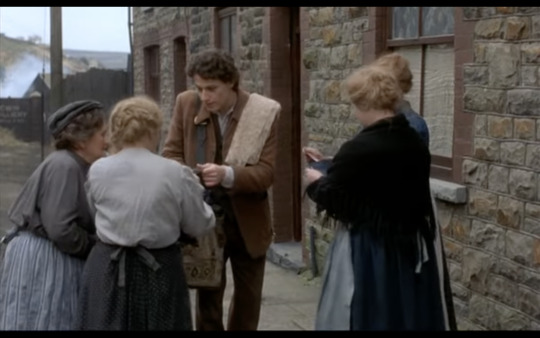

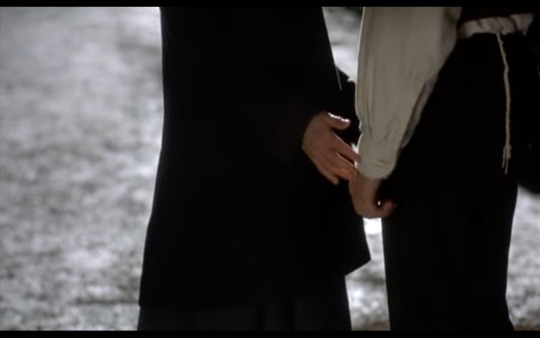
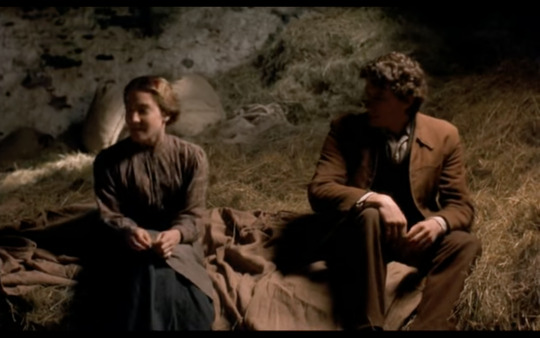
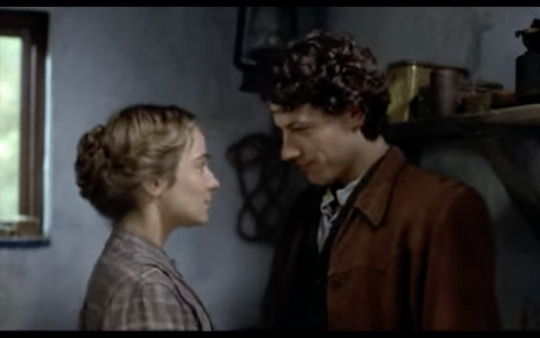
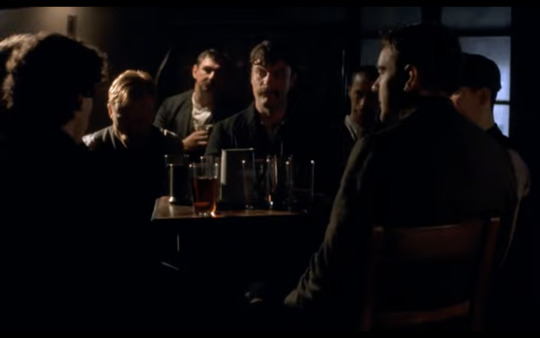
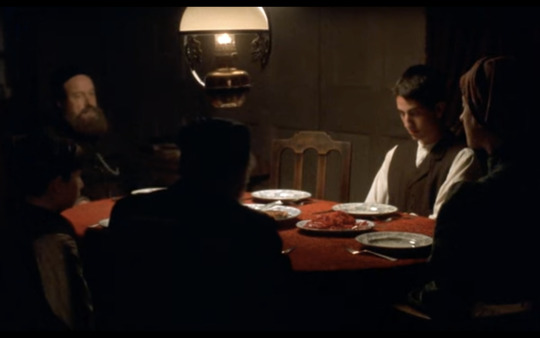

Solomon a Gaenor (1999)
1h40m | Welsh, Yiddish, & English
Y wythnos diwetha', nes i weld y ffilm 'ma. Mae hi'n am Solomon Levinsky, sy'n dod i'r Cymoedd De Cymru o Rwsia efo'i deulu, a Gaenor Rees, sy wedi byw yna ei holl fywyd. Mae Solomon a'i deulu'n Iddewon Uniongred, a mae Gaenor yn dod o deulu Anghydffurfiol, ond mae'r dau'n disgyn mewn cariad. Mae'r stori'n dipyn bach fel Romeo a Juliet, ond mae hi'n wahanol hefyd—mae'r cymeriadau'n mwy cymhleth, yn fy marn i, ac yn y diwedd o'n i ddim yn siwr beth i feddwl amdanyn nhw. Er hynny, mae'r hanes yn ddiddorol iawn, a mae'r ffilm yn sôn am y streiciau yn y Cymoedd ac am hanes Iddewig yng Nghmyru. Mae'r sinematograffi'n wych, ac o'n i'n licio'r trac sain hefyd, ond dwi'n dal i drio penderfynu am y plot. Rhaid i chi'w gweld a deud beth ydach chi'n meddwl!
Last week, I watched this film. It's about Solomon Levinsky, who comes to the South Wales Valleys from Russia with his family, and Gaenor Rees, who's lived there all her life. Solomon and his family are Orthodox Jews, and Gaenor is from a Noncomformist family, but the two fall in love. The story is a bit like Romeo and Juliet, but it's different too—the characters are more complex, in my opinion, and at the end I wasn't sure what to think about them. The history was really interesting, though, and the film talks about the strikes in the Valleys and about Jewish history in Wales. The cinematography is great, and I liked the soundtrack as well, but I'm still trying to decide about the plot. You have to watch it and tell me what you think!
Geirfa - Vocabulary
(Note: The movie is set in South Wales, so some of these are Southern Welsh variants)
swllt - shilling
cefn gwlad - countryside
cenhadwr - missionary
perthyn i - belong to, be related to
pai' bod yn ddwl - don’t be silly
rhywpryd eto - another time
tost - sick
moddion - medicine
damwain - accident
twymo - to heat up
darn - passage
tlawd - poor
cwlwm - knot
siort - type
pobi - to back
carthu - to clean
bod mas o gyrraedd - out of reach of, past
main - fine
cyhuddiad - charge, accusation
dieithryn - outsider
cosb - punishment
disgwyl babi/plentyn - to be expecting a child, to be with child
cywilydd - shame
bradychu - to betray
gwlân - wool
sodli - heel
gweddi - prayer
rheol - rule
haearn - iron
lliain - towel
pyped - puppet
dere ymlaen - come on, let’s go
carchar - prison
cyfeiriad - address
gwau - to knit
Os ti isio gweld y ffilm, mae hi ar Youtube // If you want to watch the movie, it's on Youtube:
Fersiwn Gymraeg (heb isdeitlau/isdeitlau i'r Iddew-Almaeneg yn Gymraeg) / Version in Welsh (no subtitles/subtitles for the Yiddish in Welsh)
Fersiwn Saesneg (y rhan amla' yn Saesneg efo rhannau yn Gymraeg a Iddew-Almaeneg/isdeitlau i'r holl ffilm) / Version in English (mostly English with parts in Welsh and Yiddish/subtitles for the whole film)
#i am *really* still not sure what to think about this movie but i was very pretty and it left me with lots to think about#mae'n ddrwg gen i dwi ddim yn siarad cymraeg ond dwi'n trio :'))) dwi isio gwella y flwyddyn 'ma#the welsh version and the english version were different takes so it's not dubbed which means if you watch both you get slight differences#it's also impossible to find the welsh version hence why i'm sharing it here#anyways interesting movie i'm still trying to decided how i feel about it#welsh:general#welsh:culture#welsh:vocab#welsh:practice#welsh:resources#welsh:reference#general:culture#general:vocab#general:practice#general:resources#general:reference
5 notes
·
View notes
Photo

GUILLEMELGAT’S CHRISTMAS AROUND THE WORLD | Catalunya (Catalonia)
A stall at Santa Llúcia’s Fair in Barcelona (source). The Fira de Santa Llúcia is a Christmas fair set up around the Barcelona Cathedral, starting in late November and ending right before Christmas. Vendors sell Christmas decorations of all kinds, as well as other crafts. The oldest reference to the fair is almost 300 years ago, making it a very long-running tradition.
A traditional Nativity scene at a shop in San Cugat (source). Like many of the other Christmas traditions we’ll look at, Catalans enjoy making large and detailed Nativity dioramas, often taking up entire displays in shop windows or in homes. It’s also common to go around and look at neighbors’ scenes, especially with all the hidden figures in each!
The traditional caganer figurine (source). One of the most (in)famous figures in the Catalan Nativity scene, the caganer (’pooper’) is traditionally tucked away in a corner for viewers to try to find. Traditional caganers are made to look like a Catalan peasant man, in farmer’s clothes and a red barretina hat. In recent years, however, caganers of public figures such as politicians or celebrities have become very popular as well.
A plate of Christmas stew (source). The traditional first dish of the Christmas meal in Catalonia is escudella de Nadal, a hearty soup made of large shell pasta (galets) with a meatball filling.
The Sybil’s Chant being performed in Mallorca (source). Sung at the midnight mass on Christmas Eve, this haunting Gregorian Chant was traditionally performed all across Southern Europe before being pushed away by the Church in the 16th century. The tradition only remained in Mallorca and Alguer (Sardinia), and in the late 20th century it began to be revived in Catalonia and the Valencian Country as well. Historically a young boy performed as the sybil, dressed in luxurious clothes and carrying a sword in front of them; now, it is also performed by girls as well as adults (the singer Maria del Mar Bonet in particular is known for her version).
A stall selling Christmas logs (source). A key part of Catalan Christmas celebrations is the Tió de Nadal, a log which is usually decorated with a cartoonish painted face, two legs to prop it up, and a barretina hat. The log is brought out in early December, and children feed it every day and cover it with a blanket to keep it warm. Then, on Christmas, all the children in the house take turns hitting the tió with sticks while singing a song to make it “shit” presents. Typically, these are sweets to be shared or other small gifts; larger presents are given on Three Kings’ Day.
A plate of neules, traditional Catalan Christmas cookies (source). After Christmas dinner, one of the traditional desserts in Catalonia are neules, thin, rolled-up wafer cookies, usually eaten dipped in cava (Catalan sparkling wine). The other common dessert is a type of nougat-based sweet called torró.
The St. Stephen’s Day concert at the Palau de la Música Catalana (source). The Orfeó Català, resident choir at the Palau de la Música Catalana, hosts a concert every year on the day after Christmas. The music selection typically includes tradtional Christmas carols, classical pieces, and new works for the occasion. It usually fills the entire concert hall, and is also broadcast on public television.
A plate of canelons, typically eaten on St. Stephen’s Day (source). The day after Christmas, the traditional meal is canelons, made from meat or fish rolled in sheets of pasta and covered with cheese. The filling is usually leftovers from Christmas dinner, and the tradition arose as a way to make use of them.
#this is the best one it's all downhill from here#jkjk there's actually some very good ones coming up#catalonia has a lot of unique traditions though so this was pretty easy to come up with#or maybe it's just the language and culture i'm most fluent in besides my own. who can know#catalan:general#catalan:culture#catalan:reference#general:culture#general:reference#guillemelgat's christmas around the world#la vida sense queue
30 notes
·
View notes
Photo
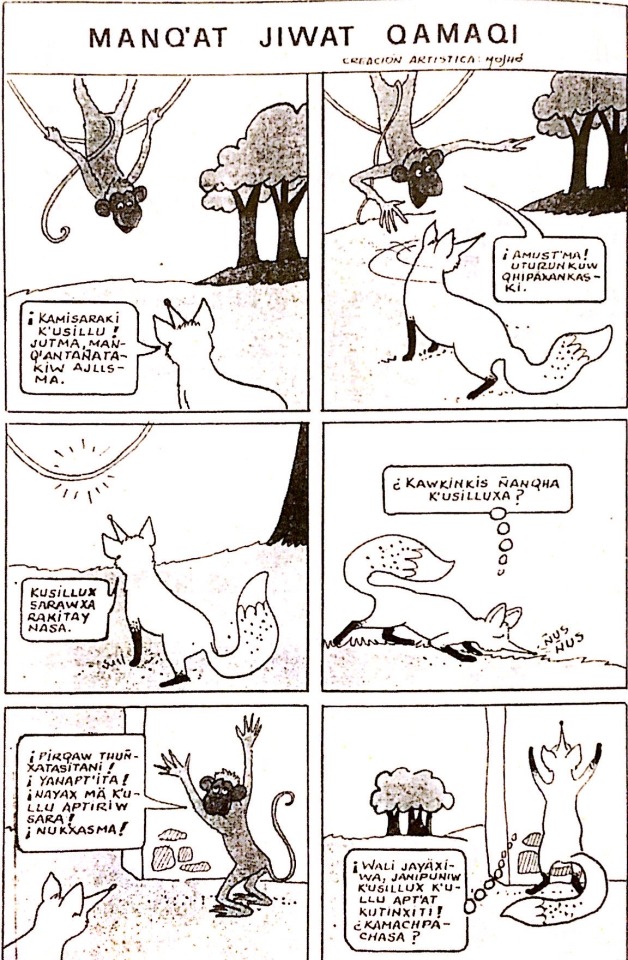

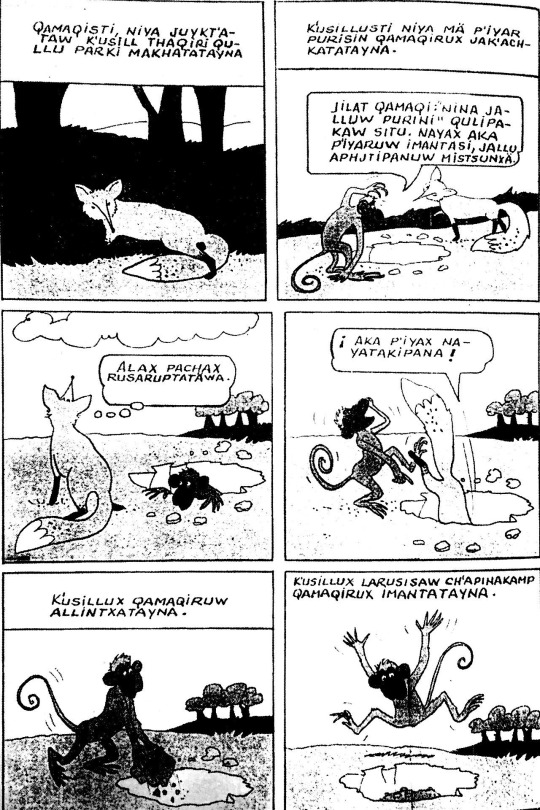
Hello @kutyozh! I was your Secret Santa for @langblrsecretsanta2021, and since you said you were interested in/studying Aymara, I thought that I would give you a gift related to that. This is a scan of a comic from Literatura aymara: antología, compiled by Xavier Albó and Félix Layme; the comic itself was drawn by Moshó for the Proyecto Bilingüe de Puno in Peru and is based on a traditional story. I’ve transcribed it below, including the original Aymara, the Spanish translation from the book, and my own English translation of the Spanish for non-Spanish speakers who are interested. Hope it’s helpful and/or enjoyable, and best of luck with your studies! 💖
MANQ’AT JIWAT QAMAQI • EL ZORRO MUERTO DE HAMBRE • THE STARVING FOX
—¡Kamisaraki k’usillu! Jutma, manq’antañatakiw ajllsma.
—¿Cómo estás, mono? Ven, te he escogido para comer.
“How's it going, monkey? Come, I’ve chosen you to eat.”
—¡Amust’ma! Uturunkuw qhipaxankaski.
—¡Piénsatelo! Detrás tuyo está el oso.
“Think carefully! There’s a bear behind you.”
—(Kusillux sarawxa rakitay nasa.)
—(¡Oh! El mono se ha escapado.)
(Oh no! The monkey escaped.)
—(¿Kawkinkis ñanqha k’usilluxa?)
—(¿Dónde está el maldito mono?)
(Where’s that damn monkey?)
—¡Pirqaw thuñxatasitani! ¡Yanapt’ita! ¡Nayax mä k’ullu aptiriw sara! ¡Nukxasma!
—¡La pared está por caerse! ¡Ayúdame! Yo iré a buscar un palo: ¿Podrías aguantar?
“The wall’s about to fall! Help me! I’m going to go look for a stick, can you hold it up?”
—(¡Wali jayäxiwa, janipuniw k’usillux k’ullu apt’at kutinxiti! ¿Kamachpachasa?)
—(¡Ya hace mucho rato y el mono nunca llega con el palo! ¿Qué hago?)
(It’s been a long time and the monkey never brought the stick! What do I do?)
—(Jichhax jakipunimamäwa.)
—(Ahora sí que te voy a encontrar.)
(Now I’m really going to find you.)
—¡Kamisasktasa!
—¿Cómo estás?
“How are you?”
—Manq’at wali awtjatatwa, jumasti wali suma manq’araktawa.
—Muerto de hambre. Y tú eres muy buena comida.
“Starving. And you’re very good food.”
—Nayraqatax khä quqar makhatt’ayita pä achu manq’ant’aniwa!
—Antes déjame subir a aquel arbol para comer un par de frutas.
“First let me climb that tree to eat a couple of fruits.”
—¡Sarma! ¡Makhatma! ¡Manq’antanma! ¡Ukat jank’akiw saraqanïta!
—Ve, sube y come. Pero baja rápido.
“Go, climb up and eat. But come down quickly.”
—¡Ayy! ¡Ayy! Janiw kuns uñjkti. ¡Janiw uñjkti!
—¡Ay! ¡Ay! ¡No veo nada!
“Oww! Oww! I can’t see anything!”
Qamaqisti, niya juykt’ataw k’usill thaqiri qullu parki makhatatayna.
Y el zorro, casi ciego, dice que subió a la ladera del cerro buscando al mono.
And the fox, almost blind, they say he climbed up the side of the hill looking for the monkey.
K’usillusti niya mä p’iyar purisin qamaqirux jak’achkatatayna.
Pero el mono llegó a la orilla de un pozo y se acercó al zorro:
But the monkey came to the edge of a well and brought the fox over.
—Jilat qamaqi: “Nina jalluw purini” qulipakaw situ. Nayax aka p’iyaruw imantasi, jallu aphjtipanuw mistsunxä.
—Hermano zorro: “Está por llover fuego” me ha dicho la señora Aguila. Yo me meteré en este pozo y saldré cuando haya pasado la lluvia.
“Brother Fox, Mrs. Eagle told me, ‘It’s about to rain fire.’ I’m going to get into this well and I’ll come out when the rain is passed.”
—(Alax pachax rusaruptatawa.)
—(Pues sí, el cielo está rosado.)
(Well indeed, the sky is pink.)
—¡Aka p’iyax nayatakipana!
—¡Este pozo es mío!
“This well is mine!”
K’usillux qamaqiruw allintxatayna.
Dice que el mono enterró bien al zorro.
They say that the monkey buried the fox well.
K’usillux larusisaw ch’apinakamp qamaqirux imantatayna.
El mono, riéndose, dejó bien guardado al zorro con espinos.
The monkey, laughing, left the fox well-guarded with thorns.
#langblrsecretsanta2021#also fyi i don't speak aymara and the transcription might have typos 😬#i hope it's somewhat useful or interesting though#let me know if you want more scans from the book!#i was really excited to do this secret santa#this is by far one of the best assignments i've gotten#and also your blog is really cool 🥺#anyways merry christmas if you celebrate and happy new year!#general:reading#general:reference#general:translation#spanish:translation#spanish:reading#spanish:general#la vida sense queue
20 notes
·
View notes
Photo

GUILLEMELGAT’S CHRISTMAS AROUND THE WORLD | Euskal Herria (Basque Country)
Vendors at the Santo Tomas Fair in Donostia (source). On December 21, many Basque towns and cities host a winter market, celebrating local farmers. Donostia hosts one of the largest ones, with lots of different vendors selling both raw and prepared products.
A family in traditional Basque clothing at the Santo Tomas Fair in Donostia (source). For the fair, it’s common for people to dress in the traditional Basque clothing: abarka shoes; long skirts and a kerchief over the head for women; and a txapela hat and kerchief around the neck for men.
A plate of txistorra sausage at the Santo Tomas Fair in Irun (source). The most common treat at the Santo Tomas Fair is txistorra, a type of sausage which is often eaten wrapped up in a talo, which is similar to the Central American tortilla.
Two servings of intxaur-saltsa, a typical Basque Christmas dessert (source). Made from walnuts, this sweet has a creamy texture and is traditional on Christmas Eve.
A model Olentzero (source). Olentzero is often called the Basque Santa Claus; however, he is a bit different. Originally said to be one of the giants of the Pyrenees and a frightening figure, over the centuries, Olentzero evolved into a kind and generous gift-giver. His current origin story is as a charcoal-burner and wood-carver who sacrificed his life to save children from a burning house. Because of this deed, he was granted eternal life in order to keep making gifts for children. Olentzero parades through many towns at Christmastime and is a beloved figure for Basque people, having survived and come out strong on the other side of Francoist repression.
Txoronpio collects letters to Olentzero in a town in the Debagoiena region (source). Olentzero has two helpers called Txoronpio and Txoronpia, who walk around with sacks and collect letters from children to deliver to him. They are depicted by people on stilts with painted faces and dressed in traditional clothing.
The creche in the life-sized Nativity scene at Florida Park in Gasteiz (source). Every year in Gasteiz, life-sized statues fill Florida Park, creating a Nativity scene that takes up a section of the park and includes over 200 figures. Nativity scenes on a smaller scale are also common across the Basque Country and surrounding areas.
The Three Kings arrive in Donostia (source). The Spanish tradition is to give gifts on January 6, with the Three Kings leaving them in children’s shoes on the night of January 5. While Olentzero gives gifts on Christmas, children in the southern part of the Basque Country often also participate in Three Kings’ Day and get double the presents! There are also parades for the Three Kings, similar to Olentzero.
A traditional roscón de reyes (source). Another shared tradition with Spain in the southern Basque Country is making roscón de reyes, a sweet cake to be eaten on January 6. The tradition goes that however finds a certain object hidden in the cake gets to wear the crown and be king for the day—similar to other Christmas sweet traditions across Europe, such as English Christmas pudding.
(Thanks to this post for inspiration)
#basque followers let me know if you have anything to add#i ran a bit short on traditions 😅#rip iparraldekoak 😔 ez dakit ezer iparraldeari buruz#basque:general#basque:culture#basque:reference#general:culture#general:reference#guillemelgat's christmas around the world#la vida sense queue
18 notes
·
View notes
Text
Food Vocabulary in Basque
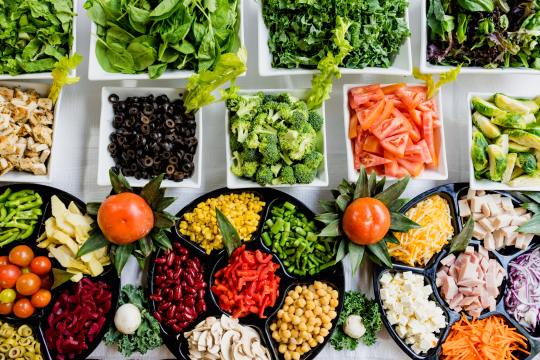
Photo by Dan Gold on Unsplash
Vocabulary related to food from my Basque class notes! Let me know if there are any mistakes. You can find the Quizlet set here!
Barazkiak - Vegetables
alberjinia - eggplant
arbi - turnip
aza - cabbage
azalore - cauliflower
azenario - carrot
baba - fava bean
babarrun - bean
baratxuri - garlic
dilista - lentil
erremolatxa - beet
garbantzu, txitxirio - chickpea
ilar - pea
kalabaza - pumpkin
kalabazin, kuiatxo - zucchini
leka - green bean
orburu, alkatxofa, artixot - artichoke
perretxiko - mushroom
perrexil - parsley
piper - pepper
porru - leek
tipula - onion
tomate - tomato
uraza, letxuga - lettuce
zainzuri - asparagus
zerba - Swiss chard
ziazerba - spinach
Frutak - Fruits
ahuakate - avocado
angurri, sandia - watermelon
gerezi - cherry
laranja - orange
limoi - lemon
mahats - grapes
mandarina - mandarin
marrubi - strawberry
meloi - melon
platano - banana
sagar - apple
txirimoia - custard apple
udare, madari - pear
Esnekiak - Dairy
esne - milk
gazta - cheese
gurin - butter
jogurt - yogurt
mami, gatzatu - curd
Haragia - Meat
azpizun - sirloin
hanburgesa - hamburger
odolki - blood pudding
oilasko - chicken
saltxitxa - sausage
solomo - loin
txistor - chistorra, pork sausage
txorizo - chorizo
txuleta - chop
urdaiazpiko - jamón, Spanish ham
xerra - steak
Arrainak - Fish
antxoa - anchovy
atun - tuna
bakailao - cod
berdel - mackerel
itsaski - shellfish
legatz - hake
muskuilu - mussel
muxila, txirla - clam
olagarro - octopus
sardina - sardine
txipiroi - squid
Janari Prestatuak - Prepared Food
albondiga, haragi-bola - meatballs
arroz-esne - rice pudding
eltzeko, erregosi - stew
entsalada - salad
entsaladilla - potato salad
ezti - honey
flan - flan
izozki - ice cream
kroketa - croquettes
natilla - custard
ogitarteko - sandwich
oilasko erre - roast chicken
opil - roll, bun
patata frijitu - french fry
patata-tortilla - potato omelette
salda - broth
tarta - cake
txokolate - chocolate
zopa - soup
Bestelako jakiak - Other Foods
arrautza - egg
arroz - rice
arto - corn
azukre - sugar
fideo - noodle
fruitu lehor - nut, dried fruit
gatz - salt
irin - flour
kafe - coffee
kamamila - chamomile
makarroi - macaroni
ogi - bread
oliba - olive
olio - oil
ozpin - vinegar
piperbeltz - pepper (spice)
te - tea
Edariak - Drinks
ardo - wine
freskagarri - soda
garagardo - beer
patxaran - pacharan (sloe aniseed brandy)
sagardo - cider
txakolin - chacoli (tangy white wine)
ur - water
zuku - juice
Jatorduak - Meals
gosari - breakfast
bazkari - lunch
askari - afternoon snack
afari - dinner
hamarretako, hamaiketako - elevenses, midmorning snack
Aditzak - Verbs
jan - eat
edan - drink
prestatu - prepare, cook
irakin - boil (water)
egosi - boil (food), bake
erosi - buy
eskatu - order
gosaldu - eat breakfast
bazkaldu - eat lunch
afaldu - eat dinner
gose izan - be hungry
egarri izan - be thirsty
#updated 14/9/21 with corrections!#okay i lied this is all i'm doing today#well maybe not entirely but i should go have tea and see the world for a bit i've been on tumblr too long#basque:general#basque:vocab#general:vocab#basque:reference#general:reference
24 notes
·
View notes
Photo

GUILLEMELGAT’S CHRISTMAS AROUND THE WORLD | ኢትዮጵያ (Ethiopia)
A Nativity scene drawn in traditional Ethiopian religious art style (source). The Ethiopian Tewahedo Orthodox Church (the main Christian denomination, and main religious denomination in general, in Ethiopia) celebrates Christmas on January 7, similar to other Orthodox Christian traditions. Christmas is referred to as ገና (gänna) or ልደት (lïdät), the second of which translates to ‘Nativity’ or ‘birth’. The most important holiday in the Tewahedo Orthodox tradition is Easter, but the Advent fast, Christmas, and Epiphany (ጥምቀት) are all also important dates in its religious calendar.
A procession of Orthodox deacons and bishops during Christmas at the holy city of Lalibela (source). Christmas services, led by Orthodox priests, are the most important part of the Christmas tradition, which is largely religious in comparison to more festive European celebrations.
A group singing Mezmur (source). An important part of Tewahedo Orthodox worship is the singing of liturgical music, known as መዝሙር (mäzmur). Though not at all exclusive to Christmas celebrations, it is often performed during them.
Pilgrims to the Church of St. George at Lalibela during Christmas (source). Built to be a second Jerusalem, and one of Ethiopia’s holiest cities, ላሊበላ (lalibela) draws in many pilgrims for Christmas celebrations. The hewn-rock churches were built in the 12th century by Emperor Gebre Mesqel Lalibela, and was declared a world heritage site in 1978. Pilgrimage is a common show of devotion for Ethiopian Orthodox members.
Worshippers at Lalibela during an overnight Christmas service (source). In the Tewahedo Orthodox tradition, as with some other Christian denominations, the Christmas mass begins at night on Christmas Eve, and often lasts until early in the morning. The candle lighting is traditional.
Boys playing the traditional Christmas game of Yegena Chewata (source). In rural areas, especially in the Ethiopian Highlands, there is a traditional Christmas game called የገና ጨዋታ (yägäna c’äwata), which is similar to field hockey. It is many centuries old and its origins are unclear; the apocryphal story of its birth is that shepherds invented it while celebrating the Nativity. It was very popular in the later period of the Ethiopian Empire, but is waning in popularity now.
A preparation of the spicy chicken stew eaten on Christmas morning (source). Orthodox Christians in Ethiopia often fast during the Advent period, and after a long night of religious services, they break that fast on Christmas morning with ዶሮ ወጥ (doro wät), a spicy chicken stew. Christmas feasts are common during the day after the service.
Ethiopian mead being poured for a customer at a bar in Lalibela (source). Another part of the Christmas feast is ጠጅ (t’äj), a drink made from fermented honey which is one of the most famous Ethiopian beverages. It is not particularly tied to Christmas; it’s drunk as an everyday alcohol as well.
Ethiopian boys in traditional clothing (source). Gift-giving is not a tradition for Ethiopian Orthodox Christians, but for Christmas children are generally given a new set of nice clothes.
#i'm only sort of familiar with this topic so let me know if you have any corrections#i learned a lot writing this though! it was really interesting#also i do realize that this is a lot more general of an overview and not amhara-specific#and that's because i came in with absolutely nowhere near enough knowledge to do that#i did want to include ethiopia in some capacity though because it's a really interesting country#amharic:general#amharic:culture#amharic:reference#general:culture#general:reference#guillemelgat's christmas around the world#la vida sense queue
10 notes
·
View notes
Photo

GUILLEMELGAT’S CHRISTMAS AROUND THE WORLD | കേരളം (Kerala)
A traditional Kerala church is lit up with Christmas lights (source). It’s typical for churches in Kerala to be strung with festive lights during the Christmas season. Around one-fifth of Malayalis are Christian, belonging to a variety of denominations; Christianity has had a presence in Kerala since the 1st century AD.
The altar of a church in Kottayum, Kerala (source). As with many Christian traditions, the most important part of Christmas is the midnight mass. Syrian Christians also often abstain from meat and fish during the Advent period.
A crib, or Nativity scene, set up by local residents for a competition in Peringammala (source). It’s common to set up elaborate Nativity dioramas, called a പുൽക്കൂട് or crib, in front of the house.
A meat curry, one of the foods often eaten for Christmas dinner (source). There is usually a large meal on Christmas, especially if people were abstaining from meat and fish or fasting beforehand. The dishes are usually meat curries, biryanis, or any traditional holiday food similar to what is served at an Onam sadya.
A traditional Syrian Christian snack food which is eaten on Christmas and other holidays (source). Called അച്ചപ്പം, the snack is made from a simple batter that is placed in an elaborate mold and fried.
A Christmas plum cake (source). Another traditional Christmas food is plum cake or fruit cake, which made and shared with friends and neighbors.
Lit-up Christmas stars hanging from a vendor’s stall (source). One of the most emblematic symbols of Christmas for Malayalis are the Christmas stars. Made from paper that has been cut and decorated, and lit up from inside, they are hung all over churches, homes, and towns at Christmas time. The star is meant to be a representation of the star that directed the Three Kings to Jesus in the original Nativity story.
A child holds a sparkler during a celebration in Kerala (source). Like other festivals in Kerala, fireworks and firecrackers are an important part of the Christmas revelry.
Children sing Christmas carols at Pallippurum Church in Ernakulu (source). It’s common from groups of performers to go around the neighborhood singing carols at people’s doors at Christmas time. In fact, the tradition, while largely Christian, is not limited by religion, and members of other religious groups sometimes go caroling as well— Christmas joy is open to all.
(Thanks to this post for being a very helpful jumping off point)
#the indian english is getting to me with that last sentence ;;-;;#no but i say that about caroling because my malayali family is hindu but a lot of them went caroling when they were younger#and have very fond memories of it <3#also the cribs and the christmas stars#if i have any christian malayali followers please feel free to send in corrections! i'm always glad to learn new things ^-^#(also don't @ me i know the sparkler website is for vishu but it was a good picture and there were none for christmas)#malayalam:general#malayalam:culture#malayalam:reference#general:culture#general:reference#guillemelgat's christmas around the world#la vida sense queue
12 notes
·
View notes
Text
Constel·lacions en anglès / Constellations in Catalan
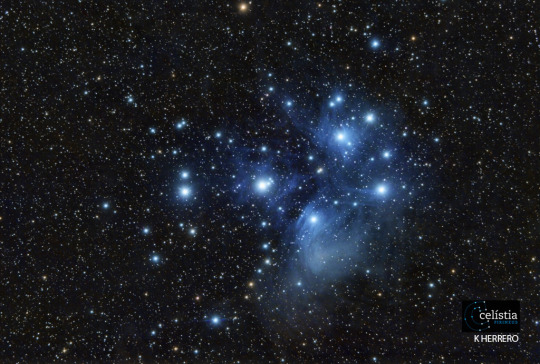
Imatge: el cúmul de les Plèiades, les set cabretes, fotografiat des de Pinyana, a l’Alta Ribagorça (tret del web de Celístia). / Image: The Pleiades star cluster, the Seven Sisters, photographed from Pinyana, in l’Alta Ribagorça, Catalonia (from the Celístia website).
Una llista dels noms i significats de les 88 constel·lacions oficials designades per la Unió Astronòmica Internacional, en anglès i en català (alguns dels noms i significats no són equivalents en les dues llengües, però he intentat de fer-los concordar al màxim possible). / A list of the names and significances of the 88 official constellations designated by the International Astronomical Union, in English and Catalan (some of the names and meanings aren’t equivalent in the two languages, but I’ve tried to make them agree as much as possible).
🌌 Andròmeda - Andromeda ⭐️ (personatge mitològica) - (mythological character)
🌌 Aquari - Aquarius ⭐️ l'aiguader (m.) - the water bearer
🌌 Àries - Aries ⭐️ el corder - the ram
🌌 Capricorn - Capricorn ⭐️ el boc - the sea goat
🌌 Cassiopea - Cassiopeia ⭐️ (personatge mitològica) - (mythological character)
🌌 Cefeu - Cepheus ⭐️ (personatge mitològic) - (mythological character)
🌌 El Bover - Boötes ⭐️ el bover - the herdsman
🌌 El Burí - Caelum ⭐️ el cisell - the chisel
🌌 El Ca Major - Canus Major ⭐️ el gos major - the greater dog
🌌 El Ca Menor - Canus Minor ⭐️ el gos menor - the lesser dog
🌌 El Camaleó - Chamaeleon ⭐️ el camaleó - the chameleon
🌌 El Cavallet - Equuleus ⭐️ el poltre - the foal
🌌 El Cavallet de Pintor - Pictor ⭐️ el cavallet de pintor - the painter's easel
🌌 El Centaure - Centaurus ⭐️ el centaure - centaur
🌌 El Cigne - Cygnus ⭐️ el cigne - the swan
🌌 El Compàs - Circinus ⭐️ el compàs - the compasses
🌌 El Corb - Corvus ⭐️ el corb - the crow
🌌 El Cotxer - Auriga ⭐️ el cotxer - the charioteer
🌌 El Cranc - Cancer ⭐️ el cranc - the crab
🌌 El Dofí - Delphinus ⭐️ el dofí - the dolphin
🌌 El Dragó - Draco ⭐️ el drac - the dragon
🌌 El Fènix - Phoenix ��️ l'au fènix (m.) - the phoenix
🌌 El Forn - Fornax ⭐️ el forn - the furnace
🌌 El Gall D'Indi - Pavo ⭐️ el gall d'indi - the peacock
🌌 El Linx - Lynx ⭐️ el linx - the lynx
🌌 El Llangardaix - Lacerta ⭐️ el llangardaix - the lizard
🌌 El Lleó - Leo ⭐️ el lleó - the lion
🌌 El Lleó Menor - Leo Minor ⭐️ el lleó menor - the lesser lion
🌌 El Llop - Lupus ⭐️ el llop - the wolf
🌌 El Microscopi - Microscopium ⭐️ el microscopi - the microscope
🌌 El Pegàs - Pegasus ⭐️ (personatge mitològic) - (mythological character)
🌌 El Peix Austral - Piscis Austrinus ⭐️ el peix austral - the southern fish
🌌 El Peix Volador - Volans ⭐️ el peix volador - the flying fish
🌌 El Rellotge - Horologium ⭐️ el rellotge de pèndola - the pendulum clock
🌌 El Reticle - Reticulum ⭐️ el reticle - the reticule
🌌 El Sagitari - Sagittarius ⭐️ l'arquer (m.) - the archer
🌌 El Serpent - Serpens ⭐️ la serp - the serpent
🌌 El Serpentari - Ophiuchus ⭐️ el portador de la serp - the serpent holder
🌌 El Sextant - Sextans ⭐️ el sextant - the sextant
🌌 El Taure - Taurus ⭐️ el bou - the bull
🌌 El Telescopi - Telescopium ⭐️ el telescopi - the telescope
🌌 El Triangle - Triangulum ⭐️ el triangle - the triangle
🌌 El Triangle Austral - Triangulum Australe ⭐️ el triangle austral - the southern triangle
🌌 El Tucà - Tucana ⭐️ el tucà - the toucan
🌌 Els Bessons - Gemini ⭐️ els bessons - the twins
🌌 Els Llebrers - Canes Venatici ⭐️ el llebrers - the hunting dogs
🌌 Els Peixos - Pisces ⭐️ el peixos - the fishes
🌌 Hèrcules - Hercules ⭐️ (personatge mitològic) - (mythological character)
🌌 L'Àguila - Aquila ⭐️ l'àguila (f.) - the eagle
🌌 L'Altar - Ara ⭐️ l'altar (m.) - the altar
🌌 L'Au del Paradís - Apus ⭐️ l'ocell del paradís (m.) - the bird of paradise
🌌 L'Eridà - Eridanus ⭐️ el riu Eridà - the River Eridanus
🌌 L'Escaire - Norma ⭐️ l'escaire (m.) - the level
🌌 L'Escorpió - Scorpio ⭐️ l'escorpí (m.) - the scorpion
🌌 L'Escultor - Sculptor ⭐️ l'escultor (m.) - the sculptor
🌌 L'Escut - Scutum ⭐️ l'escut (m.) - the shield
🌌 L'Hidra Femella - Hydra ⭐️ l'hidra de molts caps (f.) - the many-headed hydra
🌌 L'Hidra Mascle - Hydrus ⭐️ la serp d'aigua - the little water snake
🌌 L'Indi - Indus ⭐️ l'indi americà (m.) - the Native American
🌌 L'Octant - Octans ⭐️ l'octant (m.) - octant
🌌 L'Orada - Dorado ⭐️ la peix espasa - the swordfish
🌌 L'Ossa Major - Ursa Major ⭐️ l'ós gros - the great bear
🌌 L'Ossa Menor - Ursa Minor ⭐️ l'ossa menor, el carro menor - the little bear, the little dipper
🌌 L'Unicorn - Monoceros ⭐️ l'unicorn (m.) - unicorn
🌌 La Balança - Libra ⭐️ la balança - the scales
🌌 La Balena - Cetus ⭐️ la balena, el monstre marí - the whale, the sea monster
🌌 La Brúixola - Pyxis ⭐️ la brúixola - the compass
🌌 La Caballera de la Berenice - Coma Berenices ⭐️ la caballera de la reina Berenice - Queen Berenice's hair
🌌 La Coloma - Columba ⭐️ el colom - the dove
🌌 La Copa - Crater ⭐️ la copa - the cup, the chalice
🌌 La Corona Austral - Corona Australis ⭐️ la corona del sud - the southern crown
🌌 La Corona Boreal - Corona Borealis ⭐️ la corona del nord - the northern crown
🌌 La Creu del Sud - Crux ⭐️ la creu del sud - the southern cross
🌌 La Girafa - Camelopardalis ⭐️ la girafa - the giraffe
🌌 La Grua - Grus ⭐️ la grua - the crane
🌌 La Guineueta - La Vulpecula ⭐️ la guineu - the fox
🌌 La Lira - Lyra ⭐️ la lira - the lyre
🌌 La Llebre - Lepus ⭐️ la llebre - the hare
🌌 La Màquina Pneumàtica - Antlia ⭐️ la bomba d'aire - the air pump
🌌 La Mosca - Musca ⭐️ la mosca - the fly
🌌 La Popa - Puppis ⭐️ la popa - the stern
🌌 La Quilla - Carina ⭐️ la carena - the keel
🌌 La Sageta - Sagitta ⭐️ la sageta - the arrow
🌌 La Taula - Mensa ⭐️ la muntanya de la Taula - Table Mountain
🌌 La Vela - Vela ⭐️ la vela - the sail
🌌 La Verge - Virgo ⭐️ la verge - the virgin
🌌 Orió - Orion ⭐️ (personatge mitològic) - (mythological character)
🌌 Perseu - Perseus ⭐️ (personatge mitològic) - (mythological character)
#i made this for absolutely no reason and also my brain is fried idk what i'm doing#let me know if you spot typos (including in english i'm just not...brain not connecting to fingers rn)#hate all the modern constellations which is like half this list but the old ones are cool#i think i'll do another one with other astronomical terms#idk what prompted this i was gonna do train stuff but i had this list saved in my to-dos so guess what i did :))))))#catalan:vocab#catalan:general#catalan:reference#general:reference#general:vocab#lmk if the yellow isn't readable btw#i did my best but i'm never sure
23 notes
·
View notes
Photo

GUILLEMELGAT’S CHRISTMAS AROUND THE WORLD | Cymru (Wales)
A Mari Lwyd with her retinue at St Fagans in Cardiff (source). The Mari Lwyd is one of the most famous Welsh traditions. A ribbon-bedecked horse skull on a pole which is covered by a bedsheet, she comes knocking on doors and challenges anyone who answers them to pwnco, a rhyming battle (or sings them carols if it’s a gentler version).
A Plygain service at Capel Jewin, a Welsh church in London (source). Plygain is another very well-known Welsh Christmas tradition. The Plygain service was held early in the morning on Christmas day (the word plygain is said to come from the Latin for the cock’s crow, since it began before dawn). Because it was dark in the church, the people in the village would all bring candles to light up the space.
Two people singing Plygain carols at the church in Llansilin (source). Plygain services traditionally centered on the singing of carols, which would be performed a capella by one or two people. The services typically lasted until breakfast time. Many of the older carols were highly religious and almost a substitute for a sermon; modern Plygain is generally less intense. The tradition nearly died out, but several communities around Wales have maintained it for the unique singing rather than for its religious character.
A woman making Welsh treacle toffee (source). The night before Christmas, it was common to gather together and make Christmas taffy, typically during the hours before the Plygain service. The taffy was made over the stove and stretched by hand, usually while talking with family and neighbors. Another tradition in some areas was to cool off the taffy by dropping bits of it into cold water and to try to figure out who someone’s future spouse would be by seeing what letters the taffy looked like it had formed.
A greeting card with a song about Siôn Corn (source). The Welsh version of Santa Claus is Siôn Corn (‘[Chimney] Stack John’). The song on this card was written by J. Glyn Davies and is still commonly sung by children during Christmas concerts.
A box from Pembrokeshire which would be used to hold the captured wren, decorated on the outside with ribbons (source). The tradition on Twelfth Night in Pembrokeshire—or other days during Christmastide in other parts of the British Isles—was to capture the wren, a tiny bird. The wren was considered to be bad luck, and capturing it was a way to ensure a prosperous new year.
A modern group parading around the wren (source). Once captured, the wren would be brought from house to house, and people would pay to look at it within the box.
A sprig of holly, like that used for older St Stephen’s Day traditions (source). Up until several centuries ago, there was a tradition on the day after Christmas (Gwyl San Steffan) of groups of young men going around and beating the arms of girls with holly branches—or, in some cases, family members beating the last person up in the morning. This tradition, needless to say, has died out.
Two boys in Llangynwyd with their decorated apples, out to ask for Calennig (source). While not a Christmas tradition, the New Year’s tradition of Calennig is just as important of an occasion. Children would decorate an apple with three sticks and adorn it with hazelnut and boxwood leaves. They would then go from door to door, singing a song to wish the family good luck in the new year and asking for a gift (usually food or money).
#definitely didn't have to stretch this out way more than i should have#sorry i couldn't find more modern traditions#i think they conflate too much with general british ones??? not really sure#welsh:general#welsh:culture#welsh:reference#general:culture#general:reference#guillemelgat's christmas around the world#la vida sense queue
6 notes
·
View notes
Text
Steam Railway Vocab in Catalan
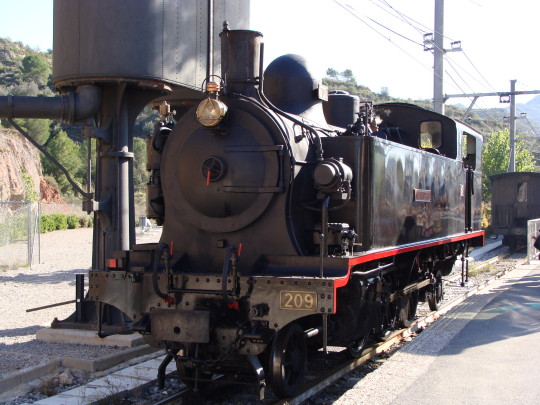
Image: The Monistrol steam engine, a restored locomotive which runs on the Llobregat-Anoia line. Photo by Luis Zamora (eldelinux) on Flickr (used under Creative Commons license 2.0).
Tipus de tren - Types of Train
el ferrocarril - railway
el tren - train
la locomotora - locomotive
de vapor - steam engine
dièsel - diesel engine
elèctrica - electric engine
de via estreta - narrow gauge engine
de tènder - tender engine
tanc - tank engine
de mercaderies - goods engine, freight train
de viatgers - passenger engine
mixta - mixed-traffic engine
de maniobres - shunting engine
la cremallera - rack railway
el tram - tram
Components - Parts
la llar - firebox
el cendrer - ashpan
la caldera - boiler
el tub - pipe
la caixa de fums - smokebox
la graella - grate
la tovera de sortida de vapor - blast pipe
la xemeneia - funnel
la cúpula - dome
de vapor - steam dome
sorrera - sand dome
el xiulet - whistle
el tènder - tender
el bastidor, el xassís - chassis, frame
el carretó - carriage
la roda - wheel
motriu - driving wheel
davantera - leading wheel
posterior - trailing wheel
l'eix (m.) - axle
el bogi - bogie
el cilindre - cylinder
el pistó - piston
la biela - connecting rod
el cigonyal - crankshaft
la manovella - crank
la barra de connexió, d'adaptació - coupling rod
el coixinet - bearing
la cabina - cab
els controls - controls
la vàlvula - valve
de seguretat - safety valve
el regulador - regulator
l'indicador (m.) - gauge
del nivell d'aigua - water gauge
de pressió - pressure gauge
el ventilador, el bufador - blower
el tir - draught (UK), draft (US)
l'injector (m.) - injector
la bomba - pump
de vapor - steam pump
d'aire - air pump
la palanca - lever
el carregador automàtic de carbó - stoker
el calfador d'aigua - water heater
el condensador - condenser
la marxa - gear
l'aixeta - spout
el flux de l'aire - air flow
el fre - brake
d'aire - air brake
la sabata de fre - brake shoe
el topall - buffer
l'enganxall (m.) - coupling (UK), coupler (US)
l'aparta vaques (m.) - cowcatcher
el llum frontal - headlight
Funcionament - Operation
el combustible - fuel
el carbó - coal
el foc - fire
el fum - smoke
el vapor - steam
l'aigua (f.) - water
Infraestructures - Infrastructure
la via - track
l'amplada de via - rail gauge
èstandard - standard guage
estreta - narrow gauge
ibèrica - Iberian gauge
la plataforma - platform
l'estació - station
la columna hídrica - water column
la senyal - signal
el canvi d'agulles, l'agulla (f.), el desviament - point (UK), switch (US)
la caseta de guardaagulles - signal box (UK), signal tower (US)
la via morta - siding
el dipòsit - yard
el garatge - shed
la cotxera - coach shed
la plataforma giratòria - turntable
el material rodant - rolling stock
el cotxe - coach
el vagó - truck (UK), freight car (US)
el taller - workshop, works
el manteniment - maintenance
la inspecció - inspection
Gent - People
el maquinista, la maquinista - driver (UK), engineer (US)
el fogoner, la fogonera - fireman
el revisor - conductor
el cap de tren, la cap de tren - guard (UK)
el guardaagulles, la guardaagulles - signalman
l'inspector (m.), la inspectora - inspector
el passatger, la passatgera - passenger
Accions - Actions
paletar - to shovel
enganxar - to couple
conduir - to drive
xiular - to whistle
cremar - to burn
bullir - to boil
canviar de via - to shunt
encendre - to light
remolcar - to pull (coaches)
xocar - to crash
arreglar - to fix
#NOT TUMBLR ALLOWING NESTED LISTS NOW#(please please please tell me it shows up for you guys i want this to work so badly)#anyways i think i peaked with this list#i can quit tumblr now i've done all i need#lmk if you have corrections because once again. it's way too late at night and my brain is fried#oki and that's all now i promise#(did i do this so i could try my hand at translating railway series into catalan?? maybe so 👀)#catalan:vocab#general:vocab#catalan:general#catalan:reference#general:reference
9 notes
·
View notes
Text

Animals in Malayalam! The header image is an Indian giant squirrel, they are very good and very big and very friend shaped.
മൃഗം /mṛgam/ - animal, beast
ആന /āna/ - elephant
സിംഹം /simham/ - lion
പുലി /puli/ - leopard
കടുവ /kaṭuva/ - tiger
പന്നി /panni/ - pig
കരടി /karaṭi/ - bear
കാള /kāḷa/ - bull
പശു /paśu/ - cow
കുറുക്കൻ /kuṛukkan/ - jackal
നായ /nāya/ - dog
കുരങ്ങ് /kuraṅṅŭ/ - monkey
കുതിര /kutira/ - horse
ഒട്ടകം /oṭṭakam/ - camel
കഴുത /kaḻuta/ - donkey
എലി /eli/ - rat, mouse
പൂച്ച /pūcca/ - cat
പോത്ത് /pōttŭ/ - buffalo (generic)
എരുമ /eruma/ - female buffalo
ആട് /āṭŭ/ - goat, sheep
പക്ഷി /pakṣi/ - bird
മയിൽ /mayil/ - peacock
കുയിൽ /kuyil/ - cuckoo
പ്രാവ് /prāvŭ/ - dove, pigeon
കാക്ക /kākka/ - crow
ഊമൻ /ūman/ - owl
കടവാതിൽ /kaṭavātil/ - bat
തത്ത /tatta/ - parrot
കിളി /kiḷi/ - sparrow, bird, parrot (?)
കഴുകൻ /kaḻukan/ - vulture
അന്നം /annam/ - swan
#words for owl and bat weren't from book they were the ones my dad uses#so may be different depending on where you're from#as always corrections/additions are welcome!#malayalam:vocab#malayalam:general#malayalam:reference#general:reference#general:vocab#learn malayalam in 30 days
25 notes
·
View notes
Text

Vocab related to feelings in Malayalam! A lot of these are more Sanskrit-y but I think they’re still fairly common.
വികാരം /vikāram/ - feeling
സന്തോഷം /santōṣam/ - happiness, joy
അനന്ദം /ānandam/ - happiness, bliss
ദേഷ്യം, കോപം /dēṣyam, kōpam/ - anger
ചിരി /ciri/ - smile, laugh
സങ്കടം /saṅkaṭam/ - sadness
കരച്ചിൽ /karaccil/ - crying
സ്നേഹം /snēham/ - affection, platonic love, friendship
പ്രേമം /prēmam/ - romantic love
ഇഷ്ടം /iṣṭam/ - liking, love (esp. non-people)
വിരോധം /virōdham/ - enmity, resentment
ദയ /daya/ - compassion
സുഖം /sukham/ - comfort
ദുഃഖം /duhkham/ - sorrow, grief
പേടി, ഭയം /pēti, bhayam/ - fear
ധൈര്യം /dhairyam/ - boldness, courage
നൈരാശ്യം /nairāśyam/ - disappointment
വിഷമം /viṣamam/ - difficulty
#corrections/suggestions/thoughts welcome!#also yes the post dump is finished you may go on with your lives#malayalam:general#malayalam:vocab#malayalam:reference#general:vocab#general:reference#learn malayalam in 30 days
25 notes
·
View notes